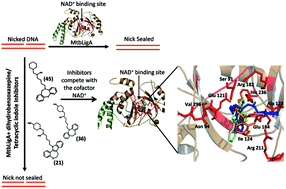Tricyclic dihydrobenzoxazepine and tetracyclic indole derivatives can specifically target bacterial DNA ligases and can distinguish them from human DNA ligase I†
Abstract
DNA ligases are critical components for DNA metabolism in all organisms. NAD+-dependent DNA ligases (LigA) found exclusively in bacteria and certain entomopoxviruses are drawing increasing attention as therapeutic targets as they differ in their cofactor requirement from ATP-dependent eukaryotic homologs. Due to the similarities in the cofactor binding sites of the two classes of DNA ligases, it is necessary to find determinants that can distinguish between them for the exploitation of LigA as an anti-bacterial target. In the present endeavour, we have synthesized and evaluated a series of tricyclic dihydrobenzoxazepine and tetracyclic indole derivatives for their ability to distinguish between bacterial and human DNA ligases. The in vivo inhibition assays that employed LigA deficient E. coli GR501 and S. typhimurium LT2 bacterial strains, rescued by ATP-dependent T4 DNA ligase or Mycobacterium tuberculosis NAD+-dependent DNA ligase (Mtb LigA), respectively, showed that the compounds can specifically inhibit bacterial LigA. The in vitro enzyme inhibition assays using purified MtbLigA, human DNA ligase I & T4 DNA ligase showed specific inhibition of MtbLigA at low micromolar range. Our results demonstrate that tricyclic dihydrobenzoxazepine and tetracyclic indole derivatives can distinguish between bacterial and human DNA ligases by ∼5-folds. In silico docking and enzyme inhibition assays identified that the compounds bind to the cofactor binding site and compete with the cofactor. Ethidium bromide displacement and gel-shift assays showed that the inhibitors do not exhibit any unwanted general interactions with the substrate DNA. These results set the stage for the detailed exploration of this compound class for development as antibacterials.


 Please wait while we load your content...
Please wait while we load your content...